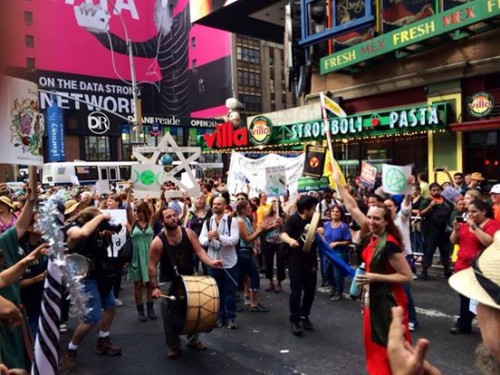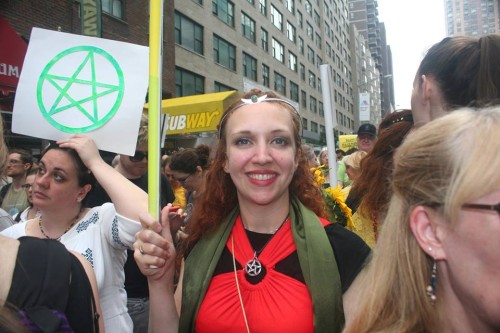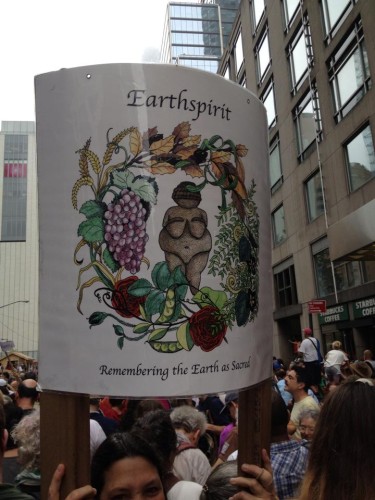[Articles like the one below take time, research and money. If you like our work and want to help us continue to share stories like this one and more, please consider donating to our fall fundraising efforts and sharing our link. It is your wonderful and dedicated support that makes it all possible. Thank you very much.]
 Wielding signs and drums and offering chants and dance, Pagans joined the nearly 400,000 people who jammed the streets of New York City for the People’s Climate March on September 21. Scheduled to take place just ahead of the United Nations 2014 Climate Summit, the event was the largest in a worldwide series of protests that may have brought out more than half a million people calling for action.The Wild Hunt spoke with several of the participants about how they organized, what they were trying to accomplish, and what may come out of this historic event.
Wielding signs and drums and offering chants and dance, Pagans joined the nearly 400,000 people who jammed the streets of New York City for the People’s Climate March on September 21. Scheduled to take place just ahead of the United Nations 2014 Climate Summit, the event was the largest in a worldwide series of protests that may have brought out more than half a million people calling for action.The Wild Hunt spoke with several of the participants about how they organized, what they were trying to accomplish, and what may come out of this historic event.
The march couldn’t have come at a better time for Courtney Weber, High Priestess of Novices of the Old Ways and member of the Pagan Environmental Coalition of New York City (PEC). Weber said the PEC was “a baby group that just started in March” when she and others “realized there needed to be a Pagan group in the work to make New York, and New York City specifically, an environmentally viable place.” Talk of “a big rally or march” was bouncing around on various activist email lists as early as May, and it seemed like a natural fit for the new group. She said:
“It started with us agreeing that we would be going to the march, then we were talking about organizing it, then it turned into organizing an entire weekend, and bring Pagans from out of town and house some of them, and getting some big speakers and making sure there’s a Pagan presence, and it turned into something really large.”
PEC’s efforts included a crowdfunding campaign to pay the travel costs for several Pagans who wanted to join the event. Seven people had their expenses covered so they could participate in the march. “That doesn’t seem like a lot to members of other religions,” Weber said, “but to have seven Pagans march with us thanks to the support of the community is a very special thing.”

PEC members hold an impromptu ritual during the march. (Credit: Groundswell Movement)
On the night before the march, PEC held a ritual and fellowship-gathering in Central Park, during which participants were encouraged to share how climate change had impacted their lives. What emerged, Weber said, was, “a message of deep concern. People spoke about droughts in their area and, for the New Yorkers, Hurricane Sandy was on our minds. We had a group coming down from Canada, which has been working really hard to fight the pipeline construction up there. We showed up as a community of faith, to say that this was a spiritual calling to be part of this march, because we regard the Earth as sacred and divine, and it was important that we be there and lend our presence and witness.”
Across the Atlantic, the Pagan Frontiers of London organized its own presence for that city’s march. Dr. Vivianne Crowley joined the group for the event. She said, “We thought it very important that there should be a Pagan presence at the pre-march multi-faith meditation, as well as at the march itself. We wanted to show that this was an issue that united faiths and we were delighted to say together (with a small Pagan adaptation) Archbishop Desmond Tutu’s prayer.”
Back in New York City, Andras Corben-Arthen offered an invocation for approximately 5,000 people just before the march began.
In the Spirit of the Earth, we are coming together;
in the Spirit of the Earth, we are one…” *
We come from the north, and we come from the south;
we come from the west, and we come from the east.
We gather from all directions
to march for this living planet
who is our home, who is what we are.
But we do not march only for ourselves,
we march for all beings of the Earth.
And so we call to sun, to wind and rain;
we call to mountains and glaciers;
we call to all who walk and crawl, who fly and swim;
we call to our ancestors, both seen and unseen;
we call to oceans and streams,
to trees, and grasses and stones
to guide and bless every step we take,
that we may once again live in harmony
with our Mother the Earth.
As it was, as it is, as it ever shall be;
with the flow and the ebb, as it ever shall be.© 2014, Andras Corban-Arthen
*© 2000, Deirdre Pulgram-Arthen
Corban-Arthen also participated in the Religions for the Earth interfaith conference, which was held in conjunction with the march. He and members of the EarthSpirit community joined the interfaith section of the march alongside PEC.
Another Pagan organization in attendance was the Pagan Cluster, whose members gathered further north on the route. Here’s their account of the interplay between the two Pagan groups:
The group [Pagan Cluster] decided to participate in the ‘We Have the Solutions’ part of the march, bringing the earth-based energy to the midst of the food justice and big NGOs section. Another contingent of pagans organized by the Peoples Environmental Coalition marched as part of the faith block. Midway through the march the pagan groups ran into each other, played with each other’s energy a bit, but ultimately brought different energies to the streets and separated out again.The Pagan Environmental Coalition had a boisterous, high-energy vibe dominated by drums.The Pagan Cluster intentionally brought an energy deeply grounded and expressed through chants, carrying the sacred woad-dyed cloth of the Living River that has been at countless actions over the past 15 years. Both energies were needed in the march and valued by those around them. At the end of the march the Pagan Cluster, having been on their feet for over eight hours and 2.5 miles of pavement, ended with a spiral dance, bringing in bystanders and raising sweet energy to feed the work needed to fight climate change.

Courtney Weber of the Pagan Environmental Coalition of New York (credit: Charles Beisser)
In the interfaith section, Pagans were “wedged between the Universalists and Humanist Jews,” Weber recalled, where “Jews marched to the sound of drums and Pagan groups followed close behind.” At one point, in what she called “a perfect moment of interfaith action for the planet,” their musical talents combined:
“Our chants were quickly adopted by members of other faith groups because they’re earth-centered, inclusive, and easy to learn. At one point, while we were singing the ‘Air I Am’ chant, a Jewish guy in a bicycle cab next to me started playing along on his clarinet.”
In London, Crowley experienced the same kind of solidarity, noting in her statement, “For us, one of the outstanding aspects of the march was the diversity of those who came. It wasn’t only dedicated environmentalists and Pagan Earth Warriors. It was all ages from 0 to 90, demonstrating a solidarity for the Earth that cut across divisions of faith, class, race, and politics.”
Historic as the Climate March was, what comes next is more important still.
“We’re all very, very tired, and there’s a sense that we want to take a break,” said Weber, “but I think that would be the worst thing we can do.The march had a carbon footprint of its own, so we have to make this count for something so that carbon we put in was not wasted.”

Credit: Charles Beisser
Crowley had similar sentiments, writing, “Climate Change marches have impact if they are linked to events like the UN summit that help give them high profile – political and business leaders are sensitive to public opinion. But marches are showpieces. It’s the actions we take every day to lessen our impact on the planet that also make a huge difference, and what we spend our money on. Consumer choices can make ‘People Power’ real.”
The summit itself was full of rhetoric but short on action, which was widely predicted. Weber reacted afterwards with a statement saying, “The words were encouraging, but what was missing were the concrete plans. President Obama pushed the need to reduce carbon emissions yet his administration is railroading the construction of dozens of liquefied natural gas export stations along both US coastlines. Natural gas is worse! Its extraction belches methane into the air which is a worse greenhouse gas than even carbon. It felt synonymous with the march in many ways: encouraging and hopeful. But like the march, the summit is a failure if specific action does not follow. I personally don’t want to hear any more leaders talk about the need to reduce climate change pollution. I want to hear specifically what they plan to do about it.”
Pagans don’t appear to be ready to rest on their laurels. New groups have emerged, such as Pagans Defending the Earth, and there are events on the horizon that can be used to continue the momentum, like the Global Frackdown on October 11. While the earth-centered religions are not able to force lightening-quick change, they are at least demonstrating the relentless pressure of a tectonic plate.
The Wild Hunt is not responsible for links to external content.
To join a conversation on this post:
Visit our The Wild Hunt subreddit! Point your favorite browser to https://www.reddit.com/r/The_Wild_Hunt_News/, then click “JOIN”. Make sure to click the bell, too, to be notified of new articles posted to our subreddit.
Hard to be a tectonic plate when everyone else is too busy laughing.
I’m an old woman and have marched more miles than I can count. An old broken ankle keeps me from doing much marching these days. But I am grateful to every person who marched and to Mr. Ward for this good report.
I just wanted to put in my 2 cents worth on the solid organizing that the Pagan Environmental Coalition put in to organizing the Pagans who marched against climate change. Although I was unable to attend due to a scheduling conflict, I was really impressed with the quality of advance information and networking that happened leading up to the event.
It’s easy to be a passionate armchair environmentalist; harder, but still relatively easy to show up for a march or an event on your own or with a group. But pulling together the myriad contacts inside NYC and out, and addressing the logistics involved in coordinating a Pagan presence at the march–that was not easy, and I think it was invaluable.
I suspect that there would have been many Pagans in attendance anyway–but knowing that we could march together probably encouraged a lot more of us to attend, and made our commitment visible for a change.
I can’t say enough good things about the work that was done leading up to the event. (I was very sorry to miss it; so many joyful photos and messages!)